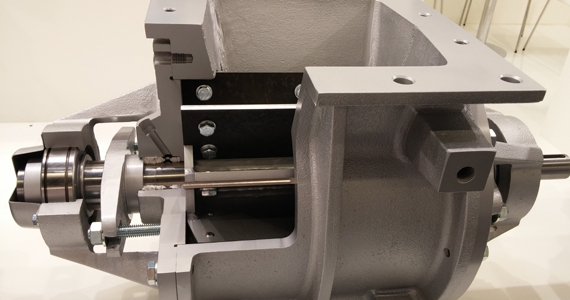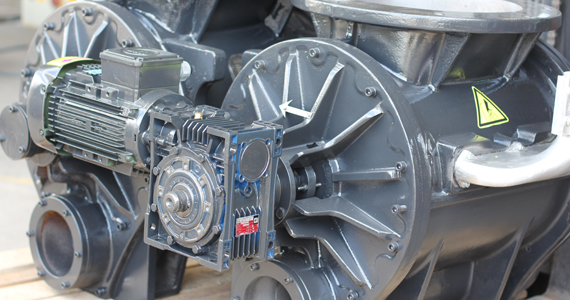WHAT IS THE ATEX AIR LOCK AND WHERE IS IT USED?
Air lock with its other name is attached, generally used in pneumatic transfer systems (pressure and vacuum) to separate the solid fluid product in the form of powder or granules and the air, fin It is the name given to a mechanical device with a flexible structure. It is widely used especially under filters and cyclones. While diameter and rotation speed determine the capacity of the device, blade tolerances are the most important factor determining the efficiency of the equipment . In addition, air locks can be used as dosers and as proportional unloaders at the bottom of the silo.ex air lock
If we briefly define the multiple functions of the capsel, air lock, rotary valve, which is mentioned by many names, it mixes the air with the powder in the form of solid fluid and gravity It can be explained that it separates the product and the compressed air from each other by making use of the force of The Air Lock can show different blade structures, tolerances, rotational speeds depending on the type of process and the product to be used in the process. The Air Lock can also act as a breaker, depending on the nature of the material to be transported. It can work in conjunction with equipment whose main function is shredder. Air Lock - Cell Wheel ST37, Carbon Steel and AISI-304 AISI-316 stainless, Hardox, Ni-Hard. Air Lock bearing types differ according to sealing elements, shaft seal, mechanical seal, seal and process. Air Lock - Cell Wheel; Internal Rotors Bladed, Rounded type, Adjustable blade type, Scraper, Polyamide, can be composed of options such as. As an extra, ATEX version air locks are also included in our production program according to the process needs.

Rotary Valves (
Airlocks) are available with square or round inlet and outlet
flanges. Housing can be fabricated out of
sheet material or cast. Common materials are cast Iron, carbon
steel, 304 SS, 316 SS, and other materials. Rotary
valve , airlock feeders
are often available in standard and heavy
duty models, the difference being the head plate and bearing
configuration. Heavy duty models use an outboard bearing in which
the bearings are moved out away from the head
plate. Housing inlet and discharge configurations are
termed
drop-thru or side entry. Different wear protections are available
such as hard chrome or ceramic plating on the
inner housing surfaces. Grease and air purge fittings
are often
provided to prevent contaminants from entering the packing seals.
Rotary Valve - Airlocks - Star Feeder may be made of ST37 Carbon
Steel and AISI-304 AISI-316 Stainless Steel. Bedding types of the
air locks may be mechanical sealing and felt, again depending on the
hot process.
EDUCTOR FOR ATEX AIR LOCKS
There are some processes that although the air lock is used in
the pneumatic transfer system, the pipe inlet-outlet orientation may
cause you trouble during maintenance. . The removal of pipes during
the said maintenance is not a highly desirable event. In plants like
this, a normal cell wheel can be used instead of a blow thru air
lock (added), and an apparatus that will have a venturi effect is
attached to the bottom. Thus, the lines connected to the system are
not disconnected while maintaining the airlock. This gives you
flexibility in the process.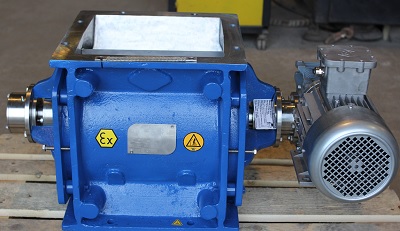
ROTARY VALVE APPLICATION
Rotary Valves (Rotary Feeders)
are widely used in the unloading and dosing of powder and granular
materials in silos, hoppers, pneumatic conveying system, bag
filters, cyclones and other equipment, in a measured and reliable
manner, allowing a detailed volumetric control in transport systems
or processing.
Bulk Solids
Grains
Powder
Fine
powder
Grease (only with special model)
Granules
Application procedures
Discharging
Metering
Feeding
Protective System
Operation
The bulk goods are fed into the
rotary valve rotor via the inlet. This is made up of several
chambers and divides the product flow into small partial flows.
These partial quantities are fed into the downstream process via the
outlet.
Range of application
Chemical
industry
Plastic industry
Pharmaceutical industry
Food industry
Similar industries
FOR atex AIR LOCKS WHAT IS LEAK AIR AND HOW DOES
IT AFFECT THE SYSTEM?
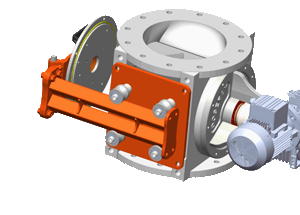 This
subject often causes misunderstandings and misuses. It should be
noted that every airlock must have a rotation tolerance to turn.
This means that there is a gap between the housing and the rotor.
They are generally set to 0.15-.0.30mm in all factory-exit air
locks. If the system will be pneumatically conveyed and the
transported material is somewhat abrasive, this tolerance may
increase over time. Increasing voids can cause problems with air
boiling and bridging upwards from the airlock.
This
subject often causes misunderstandings and misuses. It should be
noted that every airlock must have a rotation tolerance to turn.
This means that there is a gap between the housing and the rotor.
They are generally set to 0.15-.0.30mm in all factory-exit air
locks. If the system will be pneumatically conveyed and the
transported material is somewhat abrasive, this tolerance may
increase over time. Increasing voids can cause problems with air
boiling and bridging upwards from the airlock.
In order to avoid
such situations, especially the leakage air must be directed in blow
throught air locks. they can work under wear. Therefore, the
direction of the leakage air and the direction of the airlock are
important in all pneumatic transfer lines. Otherwise, even with a
very small wear, the system will experience performance problems.
It is important to use blade thicknesses, high alloy steel blades,
caps, rotational speeds, and routing of leaky air for air locks in
processes that are likely to experience wear. it does. That's why
the product selection should be paid attention in the first place.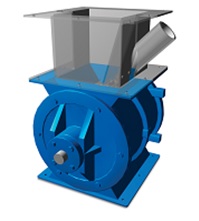
ROTARY VALVE ROTOR TYPES
-





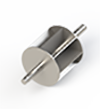

- Rotary Valve - Ailocks-Star Feeder internal
Rotors have options such as blade, rounded type, adjusted blade
type, stripper and polyamide. Discharging
valve for fine and coarse-grained products
Max. capacity through ideal ratio of rotor volume and inlet cross section
Special inlet geometry purpose-built for gentle product handling
With feeding show also suitable for feeding bulk materials into pneumatic conveying systems at up to 1.5 barg (21 psi) -
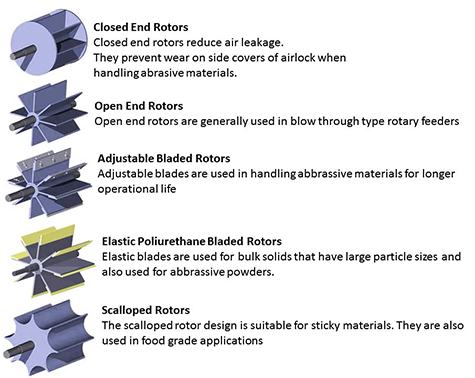
PDF
brochure

THE ATEX STANDARD FOR ROTARY VALVE
ATEX directives have been drawn up within the European
Union. Each member within the EU should incorporate these
guidelines into their national law. The ATEX directive 114
(2014/34/EU and previously ATEX 95) determines which standards
equipment and products must comply with that are used in
potentially explosive atmospheres. This directive mainly applies
to manufacturers.
ATEX CERTIFICATION FOR AIRLOCK ROTARY VALVE
Gas and dust explosions can cause enormous damage and working with explosive substances and gases therefore entails great risks. From that point of view, it is important to be able to check whether products and installations, work environments and personal competencies meet the set rules and requirements. To confirm ATEX certification is required. Thanks to the implementation of several product improvements, our outboard bearing rotary valves are now also ATEX certified for internal gas zones. This new ATEX certification is the verified proof of DOSERAY ’s high quality standards...
Drop Thru Rotary Valve Models/span>
- 120mm DRAW- cad
- 180mm DRAW-cad
- 200mm DRAW valve -cad
- 220mm DRAW-Cad -cad
- 320mm Draw-cad
- 320mm Long Type Draw -cad
- 350mm Draw-cad
- 450mm Draw-cad
Blow Thru Rotary Valve Models
While pneumatic transport processes differ according to the phases, it may also diffrent in the same phase. Low pressure, that is dilute phase transfer, can be categorized under 2 classes, namely vacuum and pressure. This classification shows, even slightly, differences in the rotary valve - airlocks. Consequently, we perform manufactures according to the air locks to be used on the vacuum and pressure line.
ROTARY VALVE capacıty
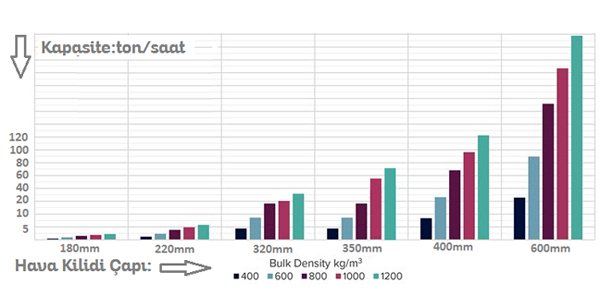
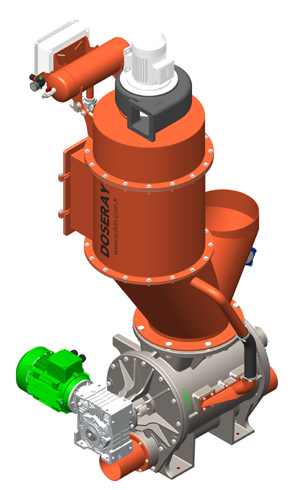
Rotary airlock feeders have wide application in industry wherever dry
free-flowing
powders, granules, crystals, or pellets are used.
Typical materials include: cement,
ore, sugar, minerals, grains,
plastics, dust, fly ash, flour, gypsum, lime, coffee,
cereals,
pharmaceuticals, etc...
- Lebels: rotary valve, rotary airlock, airlock valve, rotary feeder, blow through rotary valve, flow through airlock, silo discharge, cyclone discharge, dust collection, pneumatic conveying, rotary air lock valve, rotary valve producer, rotary valve price, rotary valve tecnichal draw
